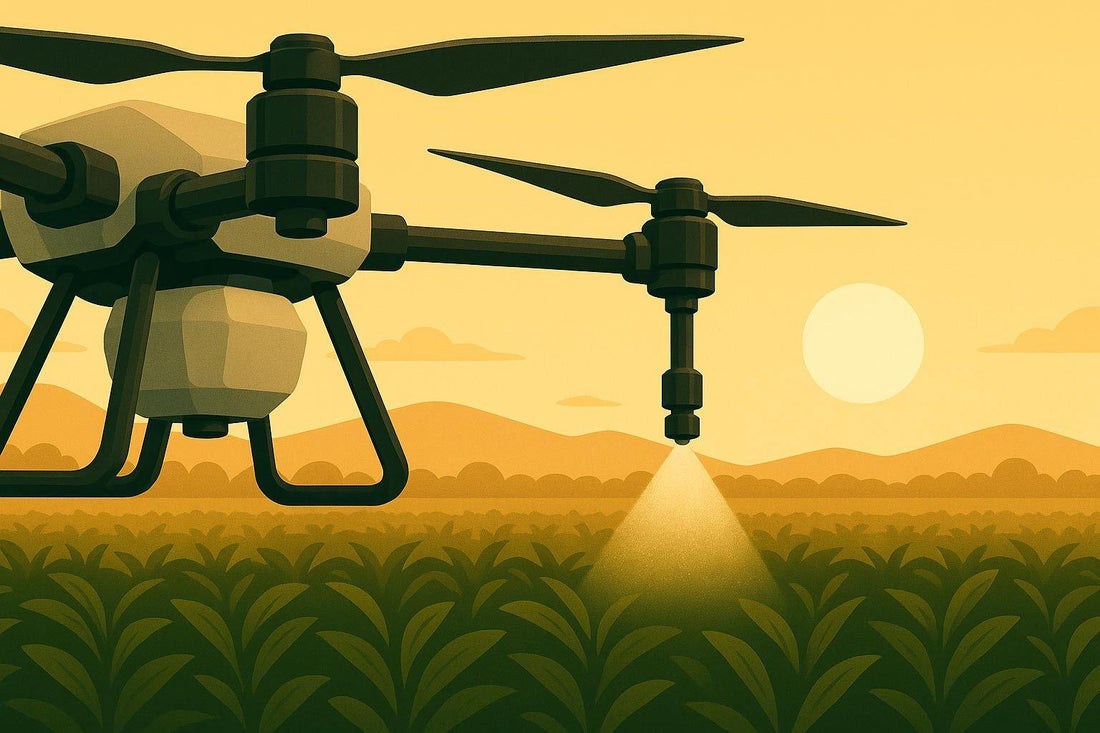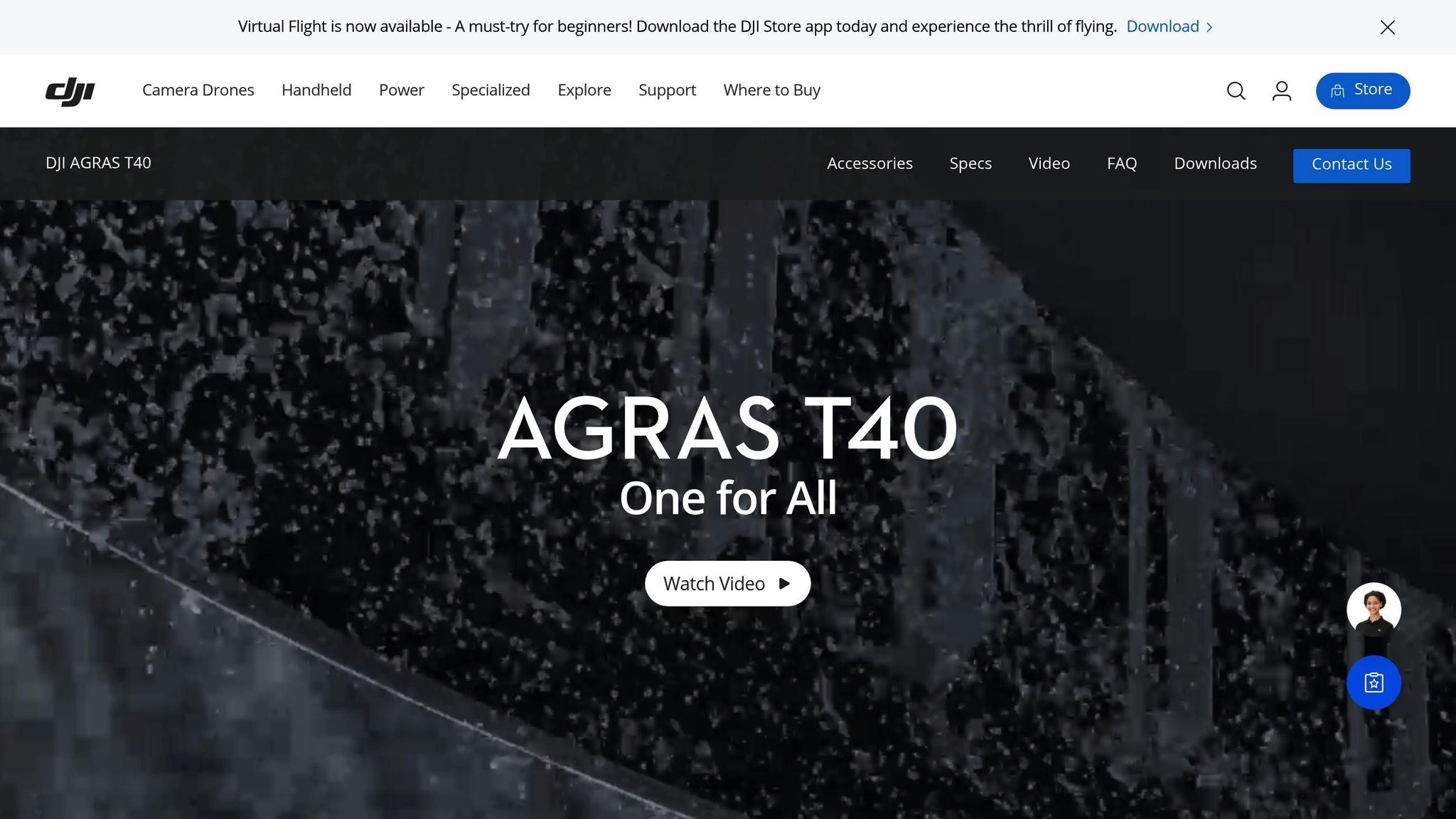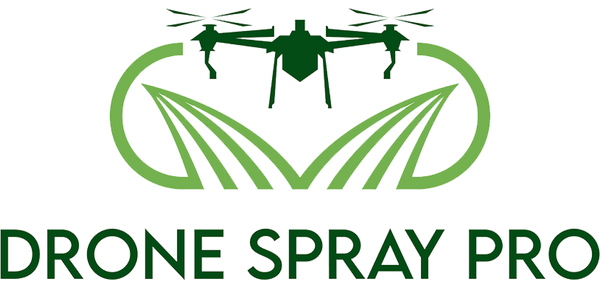
Seasonal Guide: Best Times for Drone Spraying in Idaho
Share
Drone spraying in Idaho requires precise timing to maximize crop health and yield. Here's what you need to know:
- Spring (March–May): Focus on pre-emergent herbicides and fungicides during planting, especially for potatoes (late April–early May).
- Summer (June–August): Spray fungicides (e.g., for sugar beets) every 14–21 days, coordinating with irrigation schedules.
- Fall (September–November): Time sprays to support harvest readiness, particularly for potatoes in September–October.
- Winter (December–February): Plan for the next season and maintain equipment.
Key Factors for Success:
- Wind: Operate drones when wind speeds are 2–10 mph to reduce spray drift.
- Temperature: Spray between 65°F–85°F for optimal chemical absorption.
- Rain: Avoid spraying before rain or precipitation within 24 hours.
Licenses Required: FAA Part 107, FAA Part 137, and Idaho aerial applicator license.
Ag Drones on the Rise - DJI Agras T40

Idaho's Spray Season Calendar
To make the most of drone spraying in Idaho, understanding the state's agricultural calendar is essential. By aligning spray operations with crop cycles and irrigation schedules, treatments can be applied at the right time for maximum impact. Here's a seasonal breakdown of key tasks and operations tailored to Idaho's farming schedule.
Spring Tasks (March–May)
Spring kicks off the planting season across Idaho. Potatoes are planted between early April and mid-May, with late April to early May being the busiest period. During this time, pre-emergent herbicides, soil treatments, and the first round of fungicides are applied to support emerging crops.
Luke Keller from Simplot Grower Solutions highlights the importance of water in the region:
"Pretty much anything can be grown in our area as long as we have water."
Summer Operations (June–August)
Summer is all about supporting crops during their peak growth phase. Sugar beet fields, for example, need fungicide applications every 14–21 days to manage Cercospora leaf spot. Camby Reynolds from Simplot Grower Solutions has successfully integrated drone spraying with irrigation schedules, ensuring herbicide applications are timed perfectly while keeping moisture levels consistent.
Coordinating spray schedules with irrigation cycles not only saves time but also enhances effectiveness. Proper timing is critical as drones work in sync with irrigation windows.
Fall Applications (September–November)
As fall approaches, the focus shifts to harvest preparation. Potatoes are harvested from early September through October, with the busiest period occurring in late September to early October. Spraying during this time is carefully timed to support harvest readiness and achieve the best results.
Winter Prep (December–February)
Winter is a quieter period for spraying, allowing growers to focus on planning for the next season. This is the time to review irrigation systems and water strategies for the year ahead.
Craig Yano, a grower from eastern Oregon, sums up the year-round strategy:
"We are trying to figure out how to integrate drones into our entire spray program."
Spray Timing by Crop Type
Idaho's seasonal spray calendar provides a foundation, but tailoring spray schedules to specific crops like wheat and barley can improve results. Timing drone applications to match critical growth stages in these crops helps boost yields. Below, we break down timing strategies for better spray accuracy.
Wheat and Barley Fields
For spring wheat, sprays should be applied when soil temperatures at a 2-inch depth exceed 40°F. Delaying applications beyond this point can lead to yield losses of about 1.0% per day. Monitoring soil conditions and key agronomic factors during the early growing season is essential to achieve the best results.
Weather Impact on Spray Success
Weather plays a big role in how effective spraying is in Idaho's agricultural fields. Just like timing sprays to match crop needs, adjusting to weather ensures drones perform their best.
Managing Wind Conditions
Wind speed and direction directly affect how accurately sprays are applied. For the best results, drones should operate when wind speeds are between 2–10 mph.
"We can't fly if the wind is more than 10 miles per hour. It's too difficult for a drone to stay on its path and wind increases pesticide drift risk. Under 10 mph, monitor spray and buffer the downwind field edge." - Brenden Hubele
Studies show that choosing the right time to spray can significantly reduce drift. For example, spraying at night often results in less drift compared to daytime, thanks to more stable atmospheric conditions. Using hourly weather data has shown drift load reductions of up to 86% in many cases.
Temperature and moisture levels are also critical factors that influence spray effectiveness.
Temperature and Moisture Effects
Temperature impacts how well chemicals work and how quickly plants absorb them. Most post-emergent herbicides work best between 65°F and 85°F. Outside this range, their effectiveness drops:
| Temperature Range | Spray Impact |
|---|---|
| Below 60°F | Slower weed kill and reduced chemical absorption |
| 65–85°F | Ideal range for most applications |
| Above 86°F | Faster evaporation and potential crop damage |
Spraying early in the morning or late in the afternoon often provides the most stable conditions. Higher humidity during these times reduces evaporation, allowing chemicals to stay on plant surfaces longer for better absorption.
Rain and overall field conditions also play a huge role in determining when and how to spray.
Rain and Field Conditions
One major benefit of drones is their ability to operate in conditions where traditional equipment might struggle.
"Drones allow us to spray a crop when the field is too wet after rains, they can spray small, odd shaped fields better than airplanes and ground sprayers, they handle hilly terrain and terraces very well, and they use much less fuel than ground sprayers and airplanes." - Steve Li, Associate Professor in the Auburn University College of Agriculture's Department of Crop, Soil and Environmental Sciences and a weed specialist with the Alabama Cooperative Extension System
However, active precipitation creates challenges:
- Heavy fog, rain, or snow can damage drone components
- Water droplets on sensors affect navigation accuracy
- Poor visibility increases operational risks
Always perform pre-flight checks and keep an eye on weather conditions during operations. Plan sprays for stable weather, ensuring no precipitation is expected within the next 24 hours. This approach helps maximize efficiency and minimize risks.
sbb-itb-3b7eef7
Improving Spray Results
Enhance drone spraying by focusing on battery care, proper chemical mixing, and smart irrigation scheduling. These factors work together to improve accuracy and efficiency.
Cold and Heat Effects on Batteries
Idaho's temperature fluctuations can greatly affect drone battery performance. LiPo batteries function best between 65°F and 85°F, but temperatures often fall outside this range. Here's how different conditions impact flight times:
| Temperature Range | Flight Time Impact | Suggested Actions |
|---|---|---|
| Below 14°F | Avoid operations | Delay flights |
| 14°F - 59°F | 10–15 minutes | Use battery warmers |
| 60°F - 85°F | 20–25 minutes | Normal use |
| Above 85°F | Performance drops | Fly in early mornings |
To handle winter conditions, store batteries in a warm spot before use and hover for about a minute to let them warm up. In summer, avoid flying during the hottest part of the day - schedule flights early and keep equipment in the shade.
Chemical Mixing Guidelines
The quality of water used for mixing chemicals can impact spray results, especially in areas with hard water. Test water hardness and adjust mixtures as needed:
| Water Hardness | PPM Range | Recommended Action |
|---|---|---|
| Soft | Under 50 | No treatment needed |
| Medium-Hard | 50–100 | Softening may help |
| Hard | 100–200 | Add AMS (17 lbs/100 gal) |
Use the WALES order when mixing chemicals to ensure proper blending:
- Wettable powders
- Agitate thoroughly
- Liquid flowables
- Emulsifiable concentrates
- Surfactants
For best results, time chemical applications to align with irrigation schedules.
Schedule Around Irrigation
In Idaho's dry areas, where annual rainfall is often under 14 inches, coordinating spraying with irrigation can make a big difference. For crops like sugarbeets, apply fungicides every 14–21 days, ensuring the schedule aligns with irrigation breaks. This helps maximize coverage and reduces the risk of wash-off.
In regions such as the Treasure Valley, plan sprays during irrigation pauses to improve absorption and minimize waste.
Spray Rules and Requirements
Idaho has specific drone spraying regulations to ensure safety and compliance. Below, we break down these rules to help operators meet both state and federal standards.
Chemical Use Limits by Season
To operate drones for spraying in Idaho, you’ll need the following licenses:
- FAA Part 107 pilot license
- FAA Part 137 certificate
- Idaho aerial commercial applicator license
Chemicals must be applied within specific seasonal windows based on crop growth stages. For example, herbicides like bentazon (Basagran) require a 30-day waiting period before harvesting beans and edamame. Similarly, bromoxynil (Buctril) has a 112-day interval for garlic.
Harvest Safety Periods
Following pre-harvest intervals (PHIs) ensures crops meet safety standards and regulatory requirements. These intervals vary depending on the crop and chemical used. Here’s a quick reference for some common crops in Idaho:
| Crop | Chemical | PHI (Days) |
|---|---|---|
| Sweet Corn | Clopyralid | 30 (ears/forage), 60 (stover) |
| Onions | Clethodim | 45 (bulb only) |
| Bell Peppers | Pendimethalin | 70 |
| Leafy Brassicas | Clethodim | 14 |
For the most accurate and updated PHI information, check the Pacific Northwest Pest Management Handbooks.
Protecting Beneficial Insects
To protect pollinators and other helpful insects, schedule spraying during times when their activity is low. Applying chemicals during these periods reduces the risk of exposure to managed honey bee colonies and native pollinators. Following these best practices ensures a balance between effective pest control and environmental responsibility.
Conclusion
Effective drone spraying in Idaho requires careful attention to timing, weather, and regulations. The state’s diverse landscape introduces challenges that demand tailored approaches.
Idaho’s seasonal calendar plays a key role in spray planning. Northern and western Idaho often get most of their precipitation in winter, while eastern Idaho sees higher rainfall during the summer. These weather patterns, combined with temperature changes, make precise scheduling essential.
Operators need to track local conditions, match spray applications with crop growth stages and pre-harvest intervals, follow licensing requirements, and ensure sprays are done when pollinator activity is low.
As Luke Keller from Simplot Grower Solutions says:
"Pretty much anything can be grown in our area as long as we have water."
This wide range of crops highlights the need for understanding seasonal trends to get the most out of drone spraying while being mindful of environmental factors.
Success in drone spraying depends on staying in tune with local weather, adhering to rules, and timing applications accurately. By keeping these factors in check, operators can achieve effective spray coverage while safeguarding their crops, investments, and the environment.
FAQs
What licenses do I need to operate a drone for agricultural spraying in Idaho, and how can I get them?
To legally operate a drone for agricultural spraying in Idaho, you’ll need a few key licenses and certifications. First, you must have an FAA Part 107 Remote Pilot Certificate, which is required for all commercial drone operations. You’ll also need to register your drone with the FAA. If you plan to apply agricultural chemicals, an FAA Part 137 certification is required, which regulates aerial application activities like crop dusting. For drones over 55 pounds, you’ll need to apply for specific exemptions under FAA regulations.
Additionally, Idaho law requires an Aerial Commercial Applicator License from the Idaho State Department of Agriculture (ISDA). This license ensures compliance with state regulations for aerial pesticide application. The ISDA offers study materials, exams, and training resources to help you meet the requirements. Visit their website or contact them directly for more details on obtaining the necessary certifications.
How do wind and temperature affect the success of drone spraying in Idaho?
Weather plays a critical role in the success of drone spraying. Wind speed and direction can influence how spray droplets travel, potentially causing drift that reduces accuracy and effectiveness. Too much wind can carry droplets away from the target area, while too little may prevent proper coverage.
High temperatures and low humidity can cause droplets to evaporate faster, making them smaller and more prone to drifting. This not only reduces spray efficiency but also increases the risk of damaging nearby crops or plants. For the best results, aim to spray during calm, cool mornings or evenings when temperatures are lower and winds are light.
Drones can also provide an advantage in damp conditions, as they can operate effectively in fields where traditional ground rigs might struggle. This flexibility helps ensure timely and precise applications, even in challenging weather conditions.
How can I schedule drone spraying to work best with irrigation and weather conditions for higher crop yields?
To optimize crop yields, schedule drone spraying carefully around irrigation and weather conditions. Unlike traditional equipment, drones can spray fields even when the soil is wet, eliminating the need to wait for it to dry. This flexibility allows for quicker and more efficient applications.
Weather plays a key role in effective spraying. Ideal wind speeds are between 3 to 8 mph, and the wind should blow away from sensitive areas to prevent drift. Avoid spraying during temperature inversions, which typically occur between dusk and early morning, as these conditions can cause pesticide droplets to drift over long distances. Planning around these factors ensures precise application and minimizes waste or environmental impact.
